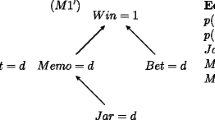Abstract
Recent advances in causal reasoning have given rise to a computation model that emulates the process by which humans generate, evaluate and distinguish counterfactual sentences. Though compatible with the “possible worlds” account, this model enjoys the advantages of representational economy, algorithmic simplicity and conceptual clarity. Using this model, the paper demonstrates the processing of counterfactual sentences on a classical example due to Ernest Adam. It then gives a panoramic view of several applications where counterfactual reasoning has benefited problem areas in the empirical sciences.
Similar content being viewed by others
References
Adams, E.: The Logic of Conditionals. D. Reidel, Dordrecht, Netherlands (1975)
Arlo-Costa, H.: The logic of conditionals. In: Zalta, E.N. (ed.) The Stanford Encyclopedia of Philosophy. http://plato.stanford.edu/entries/logic-conditionals/ (2007)
Balke, A., Pearl, J.: Counterfactuals and policy analysis in structural models. In: Besnard, P., Hanks, S. (eds.) Uncertainty in Artificial Intelligence 11, pp. 11–18. Morgan Kaufmann, San Francisco (1995)
Baron, R., Kenny, D.: The moderator-mediator variable distinction in social psychological research: conceptual, strategic, and statistical considerations. J. Pers. Soc. Psychol. 51, 1173–1182 (1986)
Campbell, D., Stanley, J.: Experimental and Quasi-Experimental Designs for Research. R. McNally and Co., Chicago, IL (1966)
Fine, K.: Review of Lewis’ counterfactuals. Mind 84, 451–458 (1975)
Galles, D., Pearl, J.: An axiomatic characterization of causal counterfactuals. Found. Sci. 3, 151–182 (1998)
Gardenfors, P.: Causation and the dynamics of belief. In: Harper, W., Skyrms, B. (eds.) Causation in Decision, Belief Change and Statistics II, pp. 85–104. Kluwer Academic Publishers (1988)
Goldszmidt, M., Pearl, J.: Rank-based systems: a simple approach to belief revision, belief update, and reasoning about evidence and actions. In: Nebel, B., Rich, C., Swartout, W. (eds.) Proceedings of the Third International Conference on Knowledge Representation and Reasoning, pp. 661–672. Morgan Kaufmann, San Mateo, CA (1992)
Haavelmo, T.: The statistical implications of a system of simultaneous equations. Econometrica 11, 1–12 (1943) (Reprinted in Hendry, D.F., Morgan, M.S. (eds.) The Foundations of Econometric Analysis, pp. 477–490. Cambridge University Press (1995))
Halpern, J.: Axiomatizing causal reasoning. In: Cooper, G., Moral, S. (eds.) Uncertainty in Artificial Intelligence, pp. 202–210. Morgan Kaufmann, San Francisco, CA (1998) (Also in J. Artif. Intell. Res. 12(3), 17–37 (2000)
Hurwicz, L.: Generalization of the concept of identification. In: Koopmans, T. (ed.) Statistical Inference in Dynamic Economic Models. Cowles Commission, Monograph 10, pp. 245–257. Wiley, New York (1950)
Joyce, J.: The Foundatins of Causal Decision Theory. Cambridge University Press, Cambridge, MA (1999)
Lewis, D.: Counterfactuals and comparative possibility. In: Harper, W.L., Stalnaker, R., Pearce, G. (eds.) Ifs, pp. 57–85. D. Reidel, Dordrecht, 1981 (1973)
Marschak, J.: Economic measurements for policy and prediction. In: Hood, W.C., Koopmans, T. (eds.) Studies in Econometric Method, pp. 1–26. Cowles Commission Monograph 10, Wiley and Sons, Inc. (1953)
Pearl, J.: Causal diagrams for empirical research. Biometrika 82, 669–710 (1995)
Pearl, J.: Causality: Models, Reasoning, and Inference, 2nd edn., 2009. Cambridge University Press, New York. (2000)
Pearl, J.: Direct and indirect effects. In: Proceedings of the Seventeenth Conference on Uncertainty in Artificial Intelligence, pp. 411–420. Morgan Kaufmann, San Francisco, CA (2001)
Pearl, J.: Causal inference in statistics: An overview. Statistics Surveys 3, 96–146. http://ftp.cs.ucla.edu/pub/stat_ser/r350.pdf (2009a)
Pearl, J.: Causality: Models, Reasoning, and Inference, 2nd edn. Cambridge University Press, New York (2009b)
Pearl, J.: The mediation formula: a guide to the assessment of causal pathways in nonlinear models. In: Berzuini, C., Dawid, P., Bernardinelli, L. (eds.) Causality: Statistical Perspectives and Applications. Tech. Rep. R-363, Department of Computer Science, University of California, Los Angeles. http://ftp.cs.ucla.edu/pub/stat_ser/r363.pdf (2011, forthcoming)
Pearl, J., Bareinboim, E.: Transportability of causal and statistical relations: a formal approach. In: Proceedings of AAAI-2011. Tech. Rep. R-372, Department of Computer Science, University of California, Los Angeles, CA. http://ftp.cs.ucla.edu/pub/stat_ser/r372-a.pdf (2011, forthcoming)
Petersen, M., Sinisi, S., van der Laan, M.: Estimation of direct causal effects. Epidemiology 17, 276–284 (2006)
Ramsey, F.: General propositions and causality. In: Mellor, H.A. (eds.) Philosophical Papers, pp. 145–153 . Cambridge University Press, Cambridge (1929)
Robins, J., Greenland, S.: Identifiability and exchangeability for direct and indirect effects. Epidemiology 3, 143–155 (1992)
Shpitser, I., Pearl, J.: What counterfactuals can be tested. In: Proceedings of the Twenty-Third Conference on Uncertainty in Artificial Intelligence, pp. 352–359. AUAI Press, Vancouver, BC, Canada (2007) (Also, J. Mach. Learn. Res. 9, 1941–1979 (2008))
Shpitser, I., Pearl, J.: Effects of treatment on the treated: Identification and generalization. In: Proceedings of the Twenty-Fifth Conference on Uncertainty in Artificial Intelligence. AUAI Press, Montreal, Quebec (2009)
Simon, H.: Causal ordering and identifiability. In: Hood, W.C., Koopmans, T. (eds.) Studies in Econometric Method, pp. 49–74. Wiley, Inc., New York, NY (1953)
Skyrms, B.: Causal Necessity. Yale University Press, New Haven (1980)
Stalnaker, R.: Letter to David Lewis. In: Harper, W.L., Stalnaker, R., Pearce, G. (eds.) Ifs, pp. 151–152. D. Reidel, Dordrecht, 1981 (1972)
Taylor, C., Dennett, D.: Who’s still afraid of determinism? Rethinking causes and possibilities. In: Kane, R.H. (ed.) The Oxford Handbook of Free Will. Oxford University Press, New York (2011, forthcoming)
Tian, J., Pearl, J.: A general identification condition for causal effects. In: Proceedings of the Eighteenth National Conference on Artificial Intelligence, pp. 567–573. AAAI Press/The MIT Press, Menlo Park, CA (2002)
Author information
Authors and Affiliations
Corresponding author
Rights and permissions
About this article
Cite this article
Pearl, J. The algorithmization of counterfactuals. Ann Math Artif Intell 61, 29–39 (2011). https://doi.org/10.1007/s10472-011-9247-9
Published:
Issue Date:
DOI: https://doi.org/10.1007/s10472-011-9247-9



